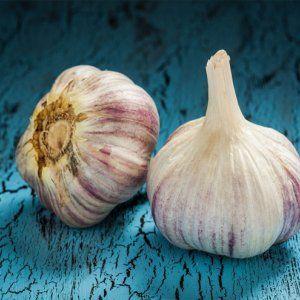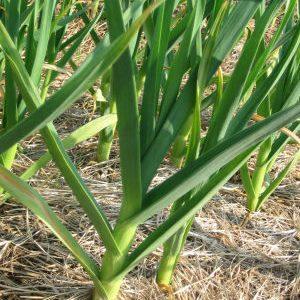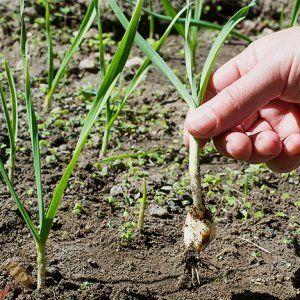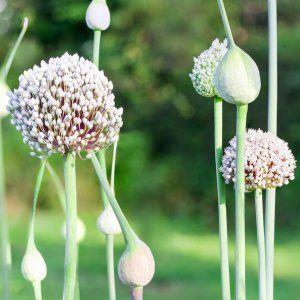We study the problem thoroughly: garlic turns yellow in the spring - what to do and how to prevent it
It happens that even experienced gardeners discover an unsightly picture in their garden beds: garlic turns yellow in spring. What to do in this case? What is the reason for this phenomenon and how to deal with it? Let's figure it out.
If the garlic has turned yellow...
First of all, make sure that your garlic not attacked by diseases or pests. To do this, pull one of the plants out of the ground and carefully examine the root crop. In some cases, this will already help you quickly understand the situation and choose the right tactics for further action.
Why do you need to dig up a plant for inspection? If the root crop is safe and sound, you need to look for another reason for the yellowing of the leaves. If there is white rot or mold on the head of garlic, you see rotten roots, a white or pinkish coating - this means that the garlic is infected.
Main reasons
There are many factors that can negatively affect the growth and development of a plant. Among the main and most common causes of yellowing of garlic leaves are climatic conditions, violation of crop rotation rules, improper care, diseases and pests.
Frosts and violation of planting rules
Frost is the most common cause of yellowing of garlic leaves. The plant could freeze slightly either in winter with very severe frosts, or already in the spring, when young shoots are exposed to spring frosts.
Planting too early can also have a negative effect on the plant.There are optimal dates for planting garlic: for central Russia - the end of September or October, for the south of Russia - November. If you plant garlic earlier, the first leaves will appear in the fall, which will freeze in winter, and then yellowed shoots will appear in the beds.
Garlic can freeze if planted very shallowly, especially in the absence of snow cover or its rapid melting. The top layer of soil freezes and the root system stops working. As a result, the plant takes all the vitality from the leaves, which turn yellow.
If garlic is planted too deeply, then in the spring the soil will not have time to warm up quickly enough, the root system will not be able to develop normally, which can also cause the leaves to turn yellow. The optimal depth for planting garlic is 4-5 cm.
You can protect your plants from low temperatures by mulching the soil. In the fall, after planting, mulch the garlic bed well with fallen leaves or sawdust. This will help future seedlings survive the winter without loss. Make the mulch layer thick so that your plantings are not afraid of any frost.
However, the question arises: if the garlic does get frozen and turns yellow, how should you treat it? This is where biostimulants come to the rescue. They will help the plant grow stronger faster and cope with unfavorable conditions.
Reference. There are many drugs that have proven themselves among gardeners: Epin-Extra, Zircon, Energen and others. All of them have an “anti-stress” effect, restore damaged shoots and promote plant growth.
Lack of moisture
A too hot spring with insufficient precipitation is the second reason. If during such a period you do not water the garden bed in a timely manner, this will inevitably lead to rapid yellowing and drying of the leaves.
But note that garlic tolerates drought better than excess moisture. Therefore, it is very important to know when to stop and not to overdo it with watering. If the air temperature in spring is within normal limits with little precipitation, water the garlic once every two weeks. There is no need to water in wet, cold spring. Also, thickly mulched beds do not need watering.
Diseases and methods of combating them
Diseases that cause yellowing of garlic leaves include white rot, bottom rot, downy mildew, yellow dwarf and mosaic.
White rot
This fungal disease causes a white coating on the root crop and roots. The leaves of the plant turn yellow. Garlic cloves become watery and soon rot. The pathogen overwinters in the soil or on root crops.
Bottom rot (fusarium)
A fungus that attacks the root system of garlic. Infection of a plant occurs in two ways: through soil or seed material. The first sign of infection is yellowed leaves, followed by rotting of the roots.
A yellow-pinkish coating forms on the root vegetables, and mold forms between the layers of husk. An increase in air temperature promotes the activation of the pathogen.
Downy mildew (peronospora)
This fungal disease also causes yellowing of garlic leaves, especially their tops. The growth of the plant slows down, its leaves completely turn yellow and dry out.
Downy mildew “loves” wet, rainy weather, but in dry and hot weather the causative agent of the disease dies.The disease is transmitted in several ways: through infected planting material, with the help of pathogens that have overwintered in the soil, and by wind carrying fungal spores.
Yellow dwarfism of garlic
This is a viral disease that manifests itself in yellowing of leaves and their modification. They become as if corrugated. Sick plants are stunted in growth (dwarfism) and do not produce a good harvest.
Mosaic
Mosaic is also a viral disease. The leaves are mainly affected, on which poorly visible specks first appear, which later merge into wide light green stripes. A “mosaic” pattern appears. Root crops grow very small and are poorly stored.
Reference. Viral diseases spread during planting and caring for plants through contaminated planting material or tools; carriers are various insects: aphids, garlic mites, etc.
Methods to combat fungal diseases
Treatment with complex fungicides will help with this problem. For example, “Tiram” (according to the instructions), “Fentiuram” (3 kg/10 l of water), “Polycarbacin” (40 g/10 l of water), “Artserid” (30 g/10 l of water).
Methods to combat viral diseases
They do not exist; such diseases can only be prevented. Therefore, it is very important to take preventive measures that will avoid both fungal and viral diseases.
Prevention of viral diseases:
- Maintain crop rotation: plant garlic in the same bed no earlier than three years later.
- Carefully remove and destroy last year's plant debris and infected plants. Not plant garlic where other onion plants were grown.
- Use healthy, well-dried seed.Warm the garlic heads in bright sun one to two days before planting.
- Water the beds with a solution of the drug “Fitosporin-M” (15 ml/10 l of water), copper oxychloride or “Bordeaux mixture” (1%).
Pests and methods of controlling them
Pests garlic are onion fly, onion moth, garlic nematode, tobacco thrips, onion root mite and others. All of them can cause significant damage to your crop, so take immediate action at the first sign of their presence.
Onion fly
This insect looks like an ordinary small fly and most often lives on loam and sandy soils. Onion fly pupae overwinter in the soil at a depth of 15-20 cm; with the onset of warmth, the insect crawls to the surface.
After one to two weeks, the fly lays eggs in the ground between plantings. After five to eight days, the eggs hatch into larvae that begin eating the garlic cloves. After two to three weeks, the grown larvae leave the corroded root crop, penetrating deep into the soil to pupate. After two weeks, the cycle repeats.
Reference. In one growing season, the onion fly can produce two or three generations and completely destroy your crop. Therefore, it is important to start fighting this insect as soon as possible.
Here are methods to combat onion flies.
Basically, various repellent solutions are used, which need to be used to treat the plants themselves and the ground around them. These same methods are also means of prevention.
An infusion of shag tobacco (250-300 g) and ground pepper (10-20 g) is especially effective. Pour the indicated mixture into 3 liters of hot water and leave for at least two days in a warm place. For best effect, cover the vessel with a warm blanket.After this, strain the solution through cheesecloth, add 20-25 g of finely grated laundry soap and dilute with water to a volume of 10 liters.
Another way to repel flies from garlic: simply sprinkle the beds with a mixture of well-chopped tobacco (5-6 g), wood ash (100-120 g) and finely ground pepper (5-6 g).
Onion moth
It is a small butterfly with a body length of about 8 mm and a wingspan of about 14 mm. It flies out with the onset of warm weather, usually in May or early June. The moth attaches its eggs to the lower surface of the leaves or to the root collar of the plant.
A week later, caterpillars appear and begin to eat young shoots. Because of this, the plant stops developing normally and longitudinal stripes appear on the leaves. A month later, a new generation of butterflies appears.
Use the same folk remedies against onion moths as against onion flies. Treating garlic during the growing season with Iskra will also help.
Garlic nematode
A nematode is a parasitic microscopic thread-like worm (helminth) that is extremely dangerous for garlic.. It is one of the most dangerous organisms that causes pathogenic processes in plants. As a result of nematode damage, large volumes of food and feed products are lost annually.
In addition, nematodes contribute to the spread of bacterial, viral and fungal plant diseases. This worm is capable of falling into a state of suspended animation and surviving any unfavorable conditions. Therefore, it is almost impossible to fight it; all that remains is to destroy the infected plants in a timely manner and in the future follow preventive measures.
There are three types of nematodes: stem, root-knot and root-knot.
The appearance of stem nematode is characterized by the pale color of the leaves, on which yellow-brownish spots appear. The stem becomes soft, the plant becomes deformed and curls.
When infected with a root-knot nematode, new growths (galls) with a diameter of up to 2 mm appear on the roots of garlic. Upon careful examination of the root crop, you can see light brown oviposition on the surface of the roots.
It is very difficult to recognize a root nematode, since it is usually associated with fungal and viral diseases, the symptoms of which overlap with the main signs of root nematode damage. These include weak growth of lateral roots, the formation of elongated yellow-brown inclusions on the roots, yellowness and dryness of the stem and leaves garlic.
Prevention methods against garlic nematode:
- purchase seed material in specialized stores;
- pre-soak the planting material in an ash solution for two hours or soak for a day in a solution of table salt with the addition of finely crushed fern leaves (160-200 g per 3 l);
- remove self-sowing garlic in a timely manner and weed the beds;
- before planting garlic, spill the soil with saline solution (20 g of salt per 3 liters of water - per 1 sq. m);
- dig up the heavy clay soil and add coarse sand and peat (one bucket per 1 sq. m);
- To deoxidize the soil, add chalk or dolomite (limestone) flour (300-400 g per 1 sq. m).
Tobacco thrips
This is a microscopic insect up to 1 mm long, light yellow or dark brown in color. Female thrips lay their eggs in the succulent tissues of garlic leaves, after which larvae hatch within a few days.They feed on the sap of the plant, which is why the garlic begins to grow poorly, the stems become sluggish, and characteristic yellowish burrows appear on the leaves. This pest overwinters in the top layer of soil.
Control method: spray the plants with celandine infusion (1 kg of dry herb per 10 liters of water, infusion time - two days).
Prevention methods: combine garlic crops with carrot crops; otherwise, the recommendations are the same as against other pests.
Onion root mite
This pest is widespread. Usually the defeat occurs already in the storage facility. However, it happens that mites attack garlic already during cultivation. It enters the garden bed along with infected planting material.
Root mites literally gnaw the head of garlic through the bottom, making their way further and further and leaving behind rot - decay products. Female ticks lay hundreds of eggs, which develop into adults in about a month.
The pest actively reproduces at any temperature above 10 degrees and loves a humid environment. Particularly favorable conditions for it are high temperature and humidity of at least 60%.
It is very difficult to notice damage to root crops, since root mites settle in the bottom and can only be detected with a thorough examination. However, already at this stage the plant’s leaves may turn yellow and dry out.
The difficulty of combating root mites, as well as the nematode, lies in the ability of this pest to survive even in the most unfavorable conditions. Females fall into a state of lethargy, hiding in hard-to-reach places or burrowing into the soil until favorable conditions for their life activity arise.
Therefore, if you find this dangerous pest in your garden, immediately destroy all infected plants and follow preventive measures in the future (see the section on garlic nematode).
Improper care and lack of minerals
If you are sure that the garlic is not infected with diseases, is not attacked by pests and could not freeze, then most likely the cause of yellowing of the leaves is a lack of minerals.
Garlic loves light sandy loam neutral soil, into which manure was added two or three years ago. The appropriate soil acidity level for garlic is 6.5. This plant does not tolerate heavy clay soil and stagnant water.
For planting, the soil must be prepared in advance: for winter garlic - at the end of summer, a month before the intended planting, for spring garlic - in the fall.
In order for the plant to develop normally, it is necessary to timely apply mineral fertilizers to the soil. Nitrogen deficiency in the soil often causes spring yellowing of garlic leaves. To avoid this, before autumn planting it is necessary to add ammonium sulfate or urea to the soil.
If you did not do this in the fall, then fertilize your garlic for the first time in spring with nitrogen as soon as plant growth begins. In rainy spring, nitrogen fertilizing is best done with urea or ammonium sulfate; in dry spring, with a solution of ammonium nitrate (20-25 g per 10 liters of water).
Garlic can also turn yellow due to potassium deficiency. In addition to yellowing, a border may appear on the edge of the leaf, making the leaf look as if it has been burned. In this case, it is good to use foliar feeding with a complex mixture or a solution of potassium chloride at the rate of 10 g per 1 liter. Do this in clear weather and when there is no wind by spraying finely.
In the spring, during the first feeding, it is good to add 100-150 g of ash per 1 square meter to the soil. m. It contains many useful microelements, including potassium and magnesium. If you added ash in the fall, but in the spring the garlic leaves still began to turn yellow, it means that some microelements are missing or they are in the wrong ratio. In this case, it is better to apply a more complete complex fertilizer for garlic according to the instructions.
Conclusion
We analyzed all the main reasons that can lead to yellowing of garlic leaves in spring, and shared folk recipes for controlling pests and diseases. Now you can create your action plan to combat this problem.
By following simple rules for growing garlic, promptly removing infected plants and fertilizing with mineral fertilizers, you can grow a wonderful harvest on your plot.